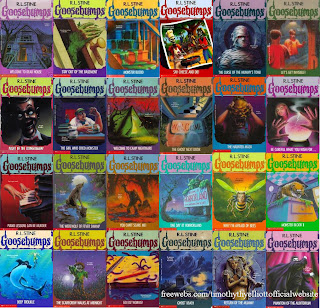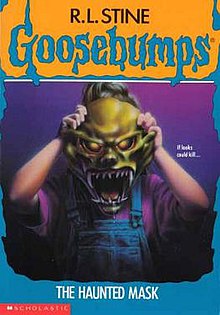Note: This is the first of several entries I’ll do on
different books or book series that were beloved by kids in the Golden
Age. They won’t be in consecutive order,
just done sporadically.
Reader Beware: You’re in for a Scare
In the early 90’s, kids loved a good scare. Whether it was our weekly date with the
Midnight Society on Are You Afraid of the Dark, staying up past our bed times
to sneak a peek at “Tales from the Crypt”, or scaring ourselves silly watching
Chuckie or Freddie Krueger, we couldn’t get enough scary stories. But perhaps no “horror” franchise was more
successful in the Golden Age than R.L. Stine’s line of Goosebumps books.
With their trademark title font and vivid cover illustrations,
Goosebumps books grabbed your attention right away. When the book case opened at your school’s
book fair or you stepped into the kids’ section at your local bookstore,
you were instantly drawn to the Goosebumps books.
Goosebumps were a winner for everyone. Kids thought it was cool to read “horror”
stories and liked the bizarre story lines and plot twists. Parents liked the fact that their kids
actually wanted to read rather than just play Genesis or Super Nintendo, and
the fact that Goosebumps books didn’t have any graphic violence or death
earned them the parents’ seal of approval.
It was the perfect recipe for success for Stine, Scholastic and the series, as
Goosebumps sold over 350 Million copies worldwide. On Publisher’s Weekly’s list of the All-Time Bestselling Children’s Books (as of 2001), 45 Goosebumps Titles were in the
greater than 1 Million copies sold category (Welcome to Dead House was tops at
over 2.1 Million copies sold, Say Cheese and Die was just behind).
Structure
Goosebumps books followed a pretty simple formula. First, Stine started with an experience that
kids could easily relate to, like spending a summer at camp or taking a trip to
an amusement park or dealing with a bully at school. He then added a protagonist who was a kid,
around the same age or perhaps slightly older than the reader. He also almost always threw in a supporting
character that was the opposite gender of the protagonist. That way, regardless of whether the reader
was male or female, they had a character with whom they could identify. Finally, Stine almost always framed his
stories by putting the characters in some new setting—whether they had just
moved to a new town or were visiting a relative on vacation, there was
generally some plot device used to make the character unfamiliar with his or her surroundings, making the events that
were about to unfold all the more frightening.
As any Goosebumps reader can tell you, the real hallmark of
the series was plot twists, both at the end of a chapter and at the end of the
book. Each book had many short
chapters, and at least a half dozen times there would be chapters with
cliffhanger endings. The ending of a
chapter might go something like:
“ and then I turned
the corner and shrieked at the top of my lungs.
There it was—the monster, charging right at me!”
Of course, within the first paragraph of the next chapter,
we learn that it wasn’t really a monster at all, but the protagonist’s friend
playing a trick on her, or a dream, or some other cheap plot device. Nevertheless, I don't ever remember feeling angry
at the books for pulling a fast one on me.
What I do remember is always telling my mother that I’d go to bed “just
as soon as I finish this chapter”, only to be unable to stop at the
cliffhanger.
Stine also loved to throw in a major twist at the end of
most of his books, some of which were totally out of left field. For instance, revealing that all the events
of the book took place on another planet in preparation for a trip to a strange
planet called Earth (Welcome to Camp Nightmare) or revealing that all of the
characters are not actually humans but dogs (My Hairiest Adventure). But even though some of the endings were
completely absurd and might make you say “WTF?” when you think about them now,
as a kid it was more of a “Whoa... Cooooooool!” reaction.
Even though they were supposed to be scary, Stine kept the
Goosebumps series pretty light-hearted on purpose (as contrasted with his Fear Street series for older readers, which was not
silly or playful like Goosebumps). Sure
some of the twists may seem over-the-top in retrospect, but really that was the
whole idea. Goosebumps was not a realistic fiction series, so why not take advantage of that and really stretch the imagination?
Top 5 Goosebumps Titles (Title only, not plot)
1. Monster Blood
The first Goosebumps book I ever read, and always one of my favorites, Monster Blood was good enough to inspire 3 separate sequels. Monsters = scary, Blood = scary, so "Monster Blood" naturally piqued a kid's attention.
2. Welcome to Camp Nightmare
Just by coincidence, this happens to be the second Goosebumps book I ever read, and arguably the biggest "WTF" ending of the series. Summer camp themes were a Stine favorite, but "Camp Nightmare" has a great ring to it.
3. The Scarecrow Walks at Midnight
This title had a unique sound to it, a little longer and more eerily declarative. Sounds like something a crazy old man would tell you in an ominous voice. Creepy.
4. A Night in Terror Tower
Have to think that this title was inspired by the popular Twilight Zone-themed ride at Disney's MGM Studios, "The Tower of Terror". It was pretty popular around the time this book came out, and Stine has admitted he borrowed a lot from The Twilight Zone. Still, the title sounds cool and is vague enough to make you curious--"What is Terror Tower? What happens in a night there?"
5. The Headless Ghost
Top 5 Goosebumps Cover Illustrations
1. The Haunted Mask
Probably one of the most iconic books in the series, The Haunted Mask's glowing eyes and ferocious teeth in front of a little girl's face instantly grabs your attention.
2. One day at Horrorland
There's a real eeriness to this cover, something uncanny about a theme park--which should be a happy, lively place--set against a foreground of desolation and death. Not to mention the Horror looming ominously. Also, bonus points for use of the "Charlotte Hornets" colors that were so popular in those years.
3. The Beast from the East
No, this one does not involve BamBam Bigelow, but apparently some sort of Koala bear crossed with a sloth and injected with steroids. I have no idea actually because I had pretty much stopped reading the series by the time this one came out, but it looks pretty intriguing and surreal with a strange creature against a lush background.
4. Calling All Creeps
Again, I have no idea what this one is about because I had stopped reading them by this point, but it looks like a bunch of velociraptors dressed like street toughs and crammed into a phone booth. How could anyone NOT be interested in that storyline?
5. The Curse of Camp Cold Lake
I will say this for Goosebumps: By the latter years of the series, Stine may have been really stretching for storylines, but Tim Jacobus and whoever else was drawing the cover art were really hitting their stride. Some of the cover art after book 40 is really excellent. I love the color scheme of The Curse of Camp Cold Lake, and a skeleton with hair emerging from (or sinking into) a fog-covered pond is as scary as it'll get for a Goosebumps book.
Legacy
About 2 and a half years ago, around Halloween, in a fit of
nostalgia for the Goosebumps books I once held dear, I decided to buy one off
of eBay-- for old times sake. It was
only a couple dollars for a used one, and I thought it would be fun to walk
down memory lane. "One Day at Horrorland" was my choice, and I was able to get through it in just a few hours.
Unfortunately, it doesn’t seem that Goosebumps books hold up
well over time. Sure, since I’m an adult
now, the books are not really aimed at my demographic; but poor writing is poor
writing, and Horrorland was laden with it.
Forgettable characters, cheesy dialogue and totally ridiculous twists
and cliffhangers were there in abundance.
And it just wasn’t really a fun read, even for nostalgia’s sake—so if
anyone out there is considering re-reading a Goosebumps book for kicks, my
advice would be to leave the memory alone.
For those interested, a blog called Blogger Beware has some
really detailed summaries and criticism of the series. He’s WAY too negative and sarcastic for my
taste, but I was glad to have some reminders of how some of the stories
unfolded, and you may be too.
But overall, I don’t want to denigrate the series the way
Blogger Beware does. If you enjoy cynics
who like to lambaste books/shows/games etc. from their childhood, you’re in
luck because the internet is full of those types. But this blog isn’t for that—this blog is to
remember why we loved those books or shows or games in the first place.
It has been almost 2 decades since R.L. Stine started
furiously cranking out Goosebumps books.
But all those years later, I still remember the excitement of seeing a
new Goosebumps book on display in a bookstore or at a book fair. Picking it up, seeing the bright colors and
the colorful illustration, reading the teaser and perhaps just as importantly,
checking the back cover to see what the next book was going to be called. I remember lining my book shelf with them, as
many as I could talk my parents into buying for me, and displaying the
collection proudly to friends. I
remember staying up late, trying to get to the end of the book before my mom
caught me. And though the writing may
not have been Newbery Medal-worthy, I remember thinking it was totally awesome
as a kid and loving the far-out plot twists.
So, nearly 20 years later, Goosebumps books are still
remembered fondly by me and many others Golden Agers. Maybe Stine isn’t such a bad writer after
all.














/56-%20The%20Curse%20of%20Camp%20Cold%20Lake%20-%20R.L.%20Stine_resizedcover.jpg)
